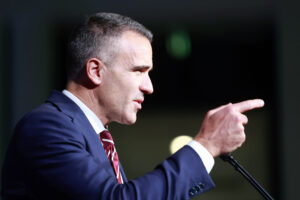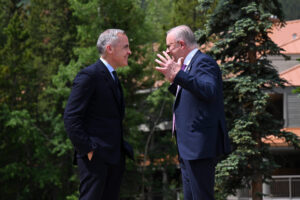The poor Labor government. It got the keys to a brand new federal government, opened the doors ready for a fresh start, but inside the place was a mess. Barely had Prime Minister Albanese turned the lights on and the gas-fired recovery had turned into a gas-fired catastrophe and an electricity market failure.
Some dings in the wall and marks on the carpet are expected as part of normal government wear and tear, but the Liberal’s energy crisis is so egregious they’ve forfeit their bond on the joint.
Samantha Maiden described it on Insiders as the ‘greatest act of policy vandalism in the last decade’ and advised Labor to do a better job of blaming those responsible: the Liberal government who had almost a decade to avoid the problems and did nothing, the ‘dinosaurs’ in the Nationals and former Energy Minister Angus Taylor who she branded a “dead man walking”.
Thankfully, Canberrans will avoid some of the worst consequences, thanks to the foresight of the ACT Government. Make no mistake, whether it is solar, wind, hydro, gas or coal, Australia has energy in abundance. Don’t let anyone tell you we have an energy shortage. So how exactly did the federal Coalition government get Australia in this mess and how do we get out of it?
Australia has an ageing fleet of coal-fired power that is increasingly unreliable, breaking down when we need it most, and a national electricity market dominated by gas and coal—both of which cost a fortune to run and fuel the climate crisis.
Though these problems have been anticipated for many years, for almost a decade the federal Coalition government completely failed to implement any kind of sensible national climate or energy policy to manage coal retirements, or to encourage investment in renewable energy and batteries to replace coal in an orderly fashion. Policy after policy was blown up by Nationals (remember Malcolm Turnbull’s NEG anyone?) causing disruptions and spooking investors. The States have been doing their best to politely work around the federal Coalition bin fire until now.
Additionally, Australia has massively ramped up its gas and coal exports, becoming the third largest exporter of fossil fuels behind Russia and Saudi Arabia, with plans for more than 100 gas and coal projects in the pipeline.
Last week, all these problems came to a head and the National Electricity Market failed. Various factors caused wholesale electricity prices in the National Electricity Market to surge astronomically, forcing the market operator to intervene and put a cap on prices. This in turn caused some fossil fuel generators to withdraw from the market saying they couldn’t provide electricity and make a profit with the price cap, even though they had capacity to spare, which in turn threatened widespread electricity outages across the market. The market operator was then forced to suspend the market temporarily to get things back under control and avoid load-shedding and blackouts.
Electricity is a necessity, an essential service, but NSW Treasurer Matt Kean ripped fossil fuel generators a new one for trying to game the system for profit, RenewEconomy described it as ‘The day the fossil fuel industry lost all perspective, and threw away its social license’.
The states most dependent on coal, NSW and Queensland, are experiencing the worst consequences. Fortunately for us here in the ACT, the territory government was on the ball years ago. Australia Institute research showed how, four years ago, the ACT became the first state or territory in Australia to achieve a transition from a fossil fuel-based supply to 100% renewable electricity. The ACT’s reverse auctions and innovative long-term contracts-for-difference will see average electricity costs fall in Canberra from 1 July, even as prices surge by up to 18% in other states.
Being 100% renewable is shielding Canberra from the chaos of gas and coal. This is the simple lesson for federal, state and territory ministers and the energy regulators going forward: get on with the transition to renewables.
If we need to invest in transmission to make this happen, do it. If there are market rules that are barriers to investment in renewables and storage, change them to create a level-playing field. While investors won’t touch gas and coal-fired power with a barge pole, they are lining up to invest in renewables and batteries.
Energy Ministers are currently looking at a so-called capacity market to fix the market failure we saw last week. Once dubbed ‘Coalkeeper’, the capacity mechanism is largely a legacy from the previous government, designed to force taxpayers to pay aging and unreliable coal-fired power stations to stay open longer. It is possible the mechanism could be redesigned, but there’s really no substitute for just building new renewable energy generation and storage. It’s the cheapest form of new energy to build and to run and it doesn’t make global warming worse. Win, win, win.
Finally, despite what you hear from the gas companies, Australia has no gas supply problem – we have a gas export problem. Australia has tripled its gas production over recent years, but gas prices keep going up because companies export around 80% of it for eye-watering export profits. Australia’s gas industry is a leaner, not a lifter. In many cases it pays no royalties and mvirtually no tax and gas prices are through the roof not because the industry is more productive or innovative but because Russia invaded Ukraine. In fact, if we need some additional revenue to fund the transition to 100% renewables, a windfall profits tax on gas is a good idea.
The best governments foresee problems and plan ahead for the future. The new federal Labor government and the States can’t fix almost a decade of inertia and delayed investment overnight, but if they commit to the transition away from fossil fuels to renewables now, the ACT has shown how all Australians can benefit in the future. If we do that, we’ll not only be looking after households and business but we’ll be looking after the planet too.
Ebony Bennett is Deputy Director of leading public policy think tank the Australia Institute, based in Canberra
Between the Lines Newsletter
The biggest stories and the best analysis from the team at the Australia Institute, delivered to your inbox every fortnight.
You might also like
I’ll admit it. Dutton is spot on about one thing when it comes to gas
It’s not often I agree with Peter Dutton, but I can admit when he’s right and he’s right about two things.
SA Premier spreads gas industry misinformation
South Australian Premier Peter Malinauskas has told an event sponsored by the gas lobby that a new gas project in Narrabri, NSW, is needed to firm up his state’s electricity supply.
Canada, don’t make the same mistake with LNG that Australia did
For decades, the populous eastern states of Australia had an abundant supply of low-cost gas.


